Workstation Ergonomics: Setting Up For A Successful Return To Work
- integratedsands
- Jan 24
- 3 min read
Updated: Feb 12
Written by Osteopath Georgia Hutchinson

Returning to work after a break? Whether it's a holiday or time off due to injury, the return to work can be both exciting and challenging. One of the most important factors in ensuring a smooth transition back is paying attention to your workspace setup. Poor ergonomics can lead to discomfort, musculoskeletal issues, and sometimes, even injuries, so it’s worth investing some time to get it right.
Here are my practical tips for creating an ergonomic work environment to support your health and wellbeing.
Why Ergonomics Matter
Ergonomics can be defined as the study of people's efficiency in their working environment. When your workstation isn’t set up to its optimal ergonomics, the likelihood of you experiencing aches, pains and strains may be increased, some concerns we see in relation to work ergonomics include;
Neck and shoulder pain
Lower back discomfort
Mid back stiffness
Wrist and hand strains
Headaches
Over prolonged periods of time, these issues may contribute to chronic pain or repetitive strain injuries (RSI). A well-designed workspace can reduce these risks and improve your comfort, productivity, and overall quality of life whilst working.
What Are The Key Components of an Ergonomic Setup
Chair Positioning
Adjust your chair so your feet are flat on the floor, with your knees at a 90-degree angle. If your feet don’t reach the floor, consider using a footrest.
Ensure your lower back is supported by the chair’s lumbar support. If your chair doesn’t have this, a cushion or rolled-up towel can help.

Desk Height
Your desk should allow your forearms to rest parallel to the ground when typing, with your elbows at a 90-degree angle.
Avoid overcrowding your desk to allow for free movement of your arms and shoulders.
Monitor Position
Position your monitor directly in front of you, approximately an arm’s length away.
The top of the screen should be at or slightly below eye level to prevent neck strain.
Use a document holder if you work with printed materials to decrease repetitive head movements up and downwards.

Keyboard and Mouse Placement
Place your keyboard and mouse close to your body to avoid overreaching.
Keep your wrists straight and relaxed. A wrist rest may help, depending on your needs.
Use keyboard shortcuts to reduce repetitive movements.

Regular Breaks and Movement
Even with the best ergonomic setup, sitting for long periods may still strain your body. Aim to:
Take regular breaks to stand, stretch, or move around.
Incorporate stretches for your neck, shoulders, and lower back during breaks.
Consider alternating between sitting and standing if you have access to a sit-stand desk.
Take small walks with at least 10-20 steps before returning to your desk every hour.

When to Seek Professional Help
If you’re experiencing ongoing discomfort despite making ergonomic adjustments, it may be time to seek advice from a health professional.
If you’re returning to work after an injury, it’s especially important to ease back into your routine with care. An osteopath can assess your specific needs, provide hands-on treatment, and offer tailored advice to support your recovery. This might include exercises to strengthen key muscle groups or strategies to reduce strain on vulnerable areas.
In Summary
Your workspace setup plays a critical role in your health, comfort, and productivity. By making small adjustments to your ergonomic set up and adding movement throughout your day, you can reduce the risk of pain and potential injury. If you’re unsure where to start or need further advice, reach out to us here at Integrated Sports and Spinal Clinic. If you need any additional support, you can also book an appointment with Georgia below.
Here’s to a healthy and productive 2025 and return to work.

Further Info & References:
WorkSafe QLD - Setting up your workstation
Safe Work Australia - How do I Set up a Workstation at Home?
Safe Work Australia - Setting up your workstation


Comentários